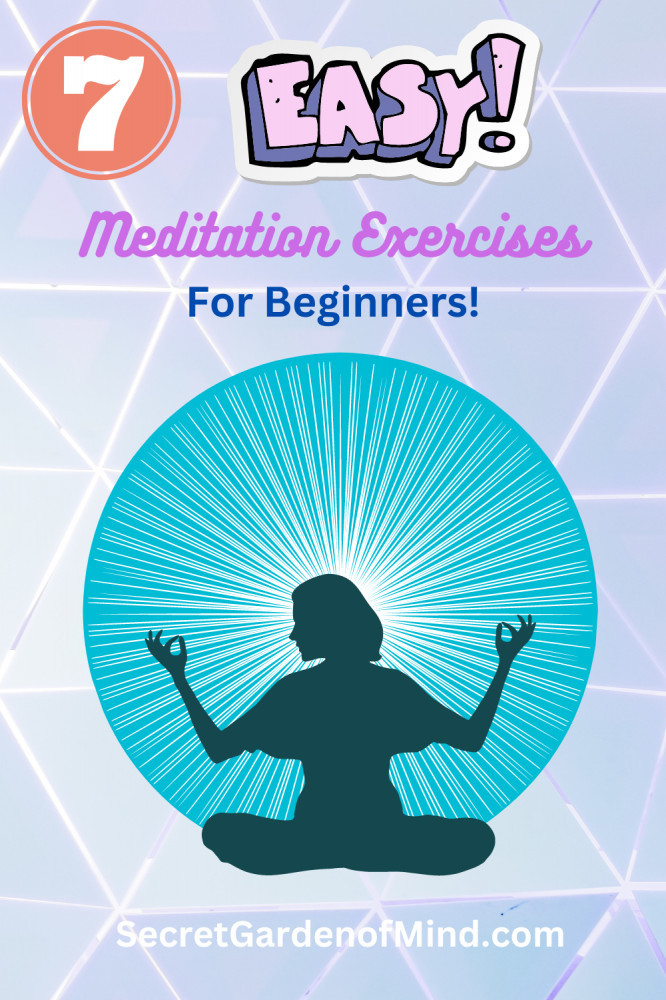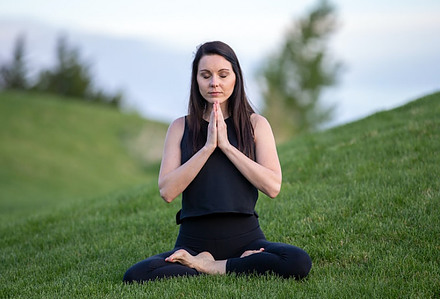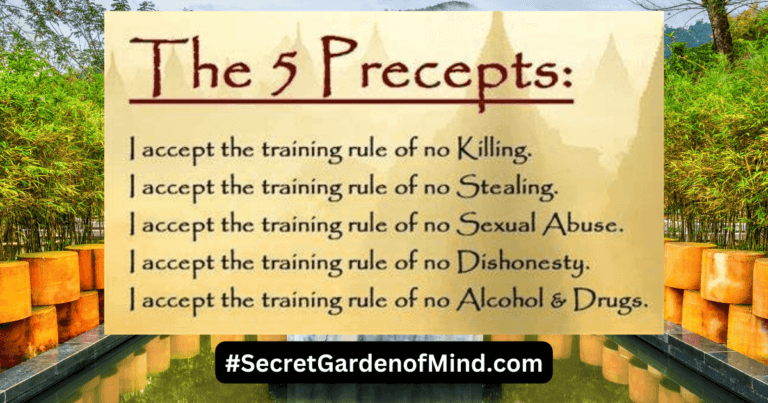7 Easy Meditation Exercises for Beginners
Are you looking to Learn Easy Meditation Exercises for Beginners?
Meditation is a simple yet powerful practice that has been used for centuries to promote relaxation, reduce stress, and enhance overall well-being. While it may seem intimidating or difficult to get started, there are plenty of easy meditation exercises for beginners that can help you achieve a state of calm and tranquility.
Whether you’re looking to reduce stress, improve focus, or simply find a few moments of peace in your day, incorporating meditation into your routine really can be a game-changer.
In this article, we’ll explore some of the best meditation exercises for beginners, including tips and techniques to help you get started and to help you adjust to making this easier every time you practice.
So, take a deep breath, relax, and let’s dive into the world of meditation. We really hope you find this information helpful
7 Easy Meditation Exercises for Beginners
Now, Meditation is a practice that has been around for thousands of years and is known for its numerous benefits for the mind, body, and spirit. From reducing stress and anxiety to improving sleep and focus, the benefits of meditation are well-documented and backed by science.
However, many people feel intimidated by the idea of meditation, thinking that it requires a lot of time, effort, or expertise. That’s why starting with easy meditation exercises is crucial for beginners.
By practicing simple meditation techniques, you can gradually build up your skills and experience the benefits of meditation without feeling overwhelmed or discouraged.
In this article, we’ll explore the benefits of meditation, the importance of starting with easy exercises, and several easy meditation techniques that anyone can practice.
So whether you’re a complete beginner or just looking to deepen your meditation practice, this article should be helpful.

Now, let’s begin, shall we…
i. Understanding Meditation

Meditation is a practice that involves training the mind to focus on the present moment and develop a sense of calm and clarity. It can be done in a variety of ways, including sitting, walking, or even moving.
Contrary to popular belief, meditation does not necessarily involve clearing the mind or achieving a state of complete stillness. Instead, it is about learning to observe your thoughts and emotions without judgment and cultivating a sense of inner peace.
One of the common misconceptions about meditation is that it is a religious or spiritual practice. While it is true that many religions and spiritual traditions incorporate meditation, it is not inherently tied to any particular belief system. In fact, meditation can be practiced by anyone, regardless of their religious or cultural background.
There are many different types of meditation, each with its own unique focus and technique. Some of the most popular types of meditation include;
- Mindfulness Meditation, which involves bringing your attention to the present moment;
- Loving-Kindness Meditation, which focuses on cultivating feelings of compassion and empathy towards yourself and others; and…
- Transcendental Meditation which uses a mantra or sound to quiet the mind and induce a state of deep relaxation.
Please keep reading to section IV. to see my top 7 Picks for Easy Meditation Exercises for Beginners.
Skip ahead if you like but anyway…
ii. What Are The Main Benefits of Meditation
Meditation has been shown to have a wide range of physical and mental benefits. Physically, meditation can lower blood pressure, reduce inflammation, and boost the immune system. Mentally, it can help reduce stress, anxiety, and symptoms of depression, as well as improve sleep, focus, and overall well-being.
Scientific research has also provided evidence to support the benefits of meditation. Studies have shown that regular meditation can increase grey matter in the brain, improve cognitive function, and even help reduce symptoms of post-traumatic stress disorder (PTSD).
Overall, the benefits of meditation are numerous and well-established. By practicing simple meditation techniques, even for just a few minutes a day, you can experience a range of physical and mental benefits that can enhance your quality of life.
iii. Getting Started with Meditation
If you’re new to meditation, it can be helpful to start with some basic techniques that are easy to follow.
Here are some tips to help you get started:
- Finding The Right Time And Place: Choose a time and place where you won’t be disturbed, and where you feel comfortable and relaxed. It can be helpful to establish a regular meditation routine, such as first thing in the morning or before bed.
- Choosing The Right Posture: Sit in a comfortable position with your back straight, either on a chair or on the floor with a cushion. Rest your hands on your lap, with your palms facing up or down, whichever feels more natural. Avoid slouching or leaning forward, as this can put a strain on your back.
- Breathing Techniques For Beginners: Focus on your breath as you inhale and exhale. You can try counting your breaths, or simply observe the sensation of the air flowing in and out of your body. If your mind starts to wander, gently bring your attention back to your breath.
One simple breathing technique that can be helpful for beginners is the 4-7-8 breathing technique. To practice this technique, inhale through your nose for a count of four, hold your breath for a count of seven, and exhale through your mouth for a count of eight. Repeat this cycle four times, or as many times as you like.
Remember, the key to successful meditation is not to judge yourself or strive for perfection. Simply focus on the present moment, observe your thoughts and emotions without judgment, and allow yourself to be present with whatever arises.
With practice, you’ll find that meditation becomes easier and more natural and that you start to experience its many benefits in no time at all. Just keep at it and if you need ideas to try and get started check out the next section below;
V. Easy Meditation Exercises for Beginners
If you’re new to meditation, it can be helpful to start with some simple exercises that are easy to follow.
Here are three techniques that are great for beginners:
1. Mindful Breathing
Step-by-step instructions:
- Find a quiet place where you won’t be disturbed, and sit in a comfortable position with your back straight.
- Focus on your breath as you inhale and exhale, counting each breath if you like.
- If your mind starts to wander, gently bring your attention back to your breath.
Tips for beginners:
- Start with just a few minutes of mindful breathing, gradually increasing the time as you become more comfortable.
- If you find it difficult to focus on your breath, try counting your breaths, or simply observe the sensation of the air flowing in and out of your body.
2. Body Scan Meditation
Step-by-step instructions:
- Find a quiet place where you won’t be disturbed, and sit or lie down in a comfortable position.
- Close your eyes and bring your attention to your body.
- Slowly scan your body from head to toe, observing any sensations or areas of tension.
- If you notice any tension or discomfort, breathe into that area and allow it to relax.
Tips for beginners:
- Start with a short body scan, focusing on just one area of the body at a time.
- If you find it difficult to focus on your body, try using a guided body scan meditation, which can be found online or on meditation apps.
3. Loving-Kindness Meditation
Step-by-step instructions:
- Find a quiet place where you won’t be disturbed, and sit in a comfortable position with your back straight.
- Bring to mind someone you care about, such as a friend or family member.
- Focus on sending them feelings of love, compassion, and kindness, silently repeating phrases such as “May you be happy, healthy, and free from suffering.”
- Repeat this process with other people, including yourself, and eventually extend these feelings to all beings.
Tips for beginners:
- Start with just a few minutes of loving-kindness meditation, gradually increasing the time as you become more comfortable.
- If you find it difficult to focus on the phrases, try visualizing the person you are sending love to, or imagining them surrounded by a warm, loving light.
4. Counting Meditation
Step-by-step instructions:
- Find a quiet place where you won’t be disturbed, and sit in a comfortable position with your back straight.
- Take a deep breath and on the exhale, count “one”.
- Repeat this for each subsequent breath, counting up to ten and then starting over at one.
- If your mind wanders, simply bring your attention back to your breath and start counting again.
Tips for beginners:
- Start with just a few minutes of counting meditation, gradually increasing the time as you become more comfortable.
- If you find it difficult to focus on your breath, try counting the length of your inhales and exhales instead.
5. Visualization Meditation
Step-by-step instructions:
- Find a quiet place where you won’t be disturbed, and sit in a comfortable position with your back straight.
- Close your eyes and imagine a calming scene, such as a beach or a forest.
- Focus on the details of the scene, including the sounds, smells, and sensations.
- Allow yourself to fully immerse in the image and let go of any thoughts or worries.
Tips for beginners:
- Start with just a few minutes of visualization meditation, gradually increasing the time as you become more comfortable.
- If you find it difficult to visualize, try looking at a picture of a peaceful scene to help you get started.
6. Walking Meditation
Step-by-step instructions:
- Find a quiet and peaceful place to walk, such as a park or a nature trail.
- As you walk, focus on the sensation of your feet touching the ground, the movement of your body, and the sounds and sights around you.
- If your mind wanders, simply bring your attention back to your walking.
Tips for beginners:
- Start with just a few minutes of walking meditation, gradually increasing the time as you become more comfortable.
- If you find it difficult to focus on your walking, try counting your steps or repeating a mantra to help you stay present.
7. Mantra Meditation
Step-by-step instructions:
- Find a quiet place where you won’t be disturbed, and sit in a comfortable position with your back straight.
- Choose a word or phrase that resonates with you, such as “peace” or “love”.
- Close your eyes and repeat the word or phrase silently to yourself, focusing on its meaning and allowing it to fill your mind and body.
- If your mind wanders, simply bring your attention back to the word or phrase.
Tips for beginners:
- Start with just a few minutes of mantra meditation, gradually increasing the time as you become more comfortable.
- If you find it difficult to focus on the word or phrase, try visualizing it in your mind’s eye or using a mala or prayer beads to help you stay focused.
So I hope these 7 ideas can give you some inspiration for your meditation exercise routines.
If you need something a bit more hands-on to try definitely check out this online course.
Maybe my tips are helpful enough but anyway let’s continue. Just before I finish this article there are a couple of things…
VI. Maintaining Your Meditation Practice
After starting your meditation practice, it is important to continue and maintain it in the long term.
Here are some common challenges you might face and how to overcome them:
- Lack Of Time: If you find it difficult to make time for meditation, try setting a regular time each day and making it a non-negotiable part of your routine. You can also break up your meditation into shorter sessions throughout the day.
- Difficulty Focusing: It is natural for your mind to wander during meditation. When this happens, gently bring your attention back to your breath or your chosen focus. As you continue to practice, you will find it easier to maintain your focus. My tip is to begin counting and if you get distracted start again from number 1.
- Self-Doubt: It is common to doubt the effectiveness of meditation or to feel like you’re not doing it “right.” Remember that there is no right or wrong way to meditate, and the benefits can be subtle but profound.
viii.) Making Meditation a Habit:
As well as maintaining your meditation practice another thing that is very important is making meditation a habit.
Some things you can try to make this more actionable include;
- Start Small: Begin with just a few minutes of meditation each day and gradually increase the length of your sessions as you become more comfortable.
- Be Consistent: Try to meditate at the same time and in the same place each day. This will help to create a habit and make it easier to stick to your practice.
- Find a Community: Joining a meditation group or finding a meditation partner can help you stay motivated and accountable.
- Tracking Progress and Staying Motivated: To really help get into the habit of daily meditation some things you can do include keeping a meditation journal that can help you track your progress and identify any patterns or obstacles that arise. Celebrate Small Wins: Recognize and celebrate the small improvements you make in your practice, such as sitting for a few minutes longer or maintaining focus for a longer period of time.
And of course, remember your “why”! Keep in mind the reasons why you started meditating in the first place and the benefits you have experienced. This can help to motivate you to continue even on days when it feels challenging.
I will now wrap this up here but any questions I will be glad to try and answer them in the comments.
VII. Conclusion
In conclusion, meditation is a simple yet powerful tool for improving your physical and mental well-being. Starting with easy meditation exercises for beginners can help you establish a regular practice routine and experience the benefits of meditation.
By maintaining your practice and overcoming common challenges, you can make meditation a lasting habit and reap the rewards of a more mindful and peaceful life.





Hey Alex,
I practice sitting practices myself and find your article is a very useful guide for beginners! A lot of practices and you even mention some challenges that might come up, thanks. What is your favorite sitting practice?
Take care
Thimo
Hi Thimo, Thanks glad you liked. My favourite sitting practice is probably lotus position.
I was looking for a clear article for my yoga students to go to. And I think I found the perfect match. I often put meditation into my yoga classes, but my students sometimes ask me how to continue their practice even outside my classes. I tell them everything that is written above here. So I will give them this link next time to make sure they have it available for them on paper!
And PS: The loving kindness meditation is my all-time favourite meditation!!!